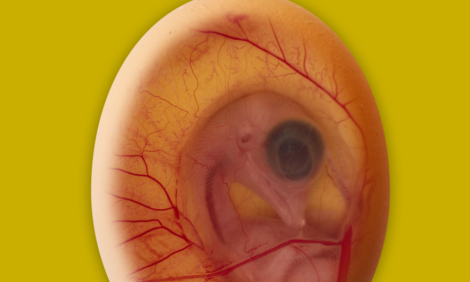



Spiking Mortality Syndrome Suspected - VLA
UK - In the latest AHVLA Scanning Surveillance Report, late cut silage was associated with signs of ergotism, with 8/26 affected cattle euthanased, streptococcus suis type 2 remains a prominent cause of pig mortality and hypoglycaemia - spiking mortality syndrome was suspected in a three week old broiler flock.Commercial Layers
Brachyspira intermedia
Loss of egg production and abnormal faeces were reported in two free-range layer flocks, prompting the submission of birds for investigation. In one of the flocks, aged 22-weeks, post mortem findings included slightly distended and flaccid small intestines with thin mucoid ingesta and enlarged caeca with pasty contents. Faecal gas bubbles, mucus and blood had also been observed clinically. Brachyspira intermedia, a pathogenic species in chickens, was isolated from both flocks indicative of a diagnosis of avian intestinal spirochaetosis. In one of the flocks, Brachyspira innocens, considered to be a non-pathogenic species, was incidentally isolated.
Broilers & Broiler Breeders
Spiking mortality syndrome
“Hypoglycaemia - spiking mortality syndrome” was the tentative diagnosis in a 21-day-old commercial broiler flock with a history of sudden and transient increased mortality. Post-mortem examination findings included congested livers, myocardial pallor, areas of renal pallor and congestion and scant feed in the upper digestive tract. Histopathological examination of heart and kidney tissues revealed abnormal lipid accumulations consistent with mobilisation of fat as an alternative energy source, which provided supportive evidence for the diagnosis. A definitive diagnosis depends on the demonstration of blood glucose levels below 150mg/dl (8.3mmol/l), and is usually only possible if moribund birds are found during such an episode and blood collected into fluoride oxalate tube for glucose estimation.
Cardiovascular conditions
Broiler ascites syndrome was diagnosed in 25- and 27-day-old broilers with a history of slightly increased mortality. Post-mortem examination revealed right ventricular dilatation, marked visceral and lung congestion with straw-coloured fluid free in the abdominal cavity. In one bird, nodular cauliflowerlike proliferative lesions of vegetative endocarditis were also observed from which Enterococcus hirae was isolated. In a separate 13-day-old broiler flock, investigated due to increased mortality and lameness, septicaemia and vegetative endocarditis due to E. hirae infection were diagnosed.
Infectious Bronchitis
Infection with variant Infectious Bronchitis viruses (IBV) was identified using molecular methods in several commercial broiler flocks aged between 13 and 49 days and located in the east and north of England. A variety of clinical problems were reported including respiratory disease, tracheitis, diarrhoea, wet litter and poor live weight gain. Increasing mortality was reported in a 37-day-old broiler flock associated with European QX-like IBV infection.
Turkeys
Ornithobacterium rhinotracheale
Lethargy and the loss of six turkeys from a group of 320 birds prompted investigation. Post mortem findings indicated pneumonia with pulmonary congestion evident. Ornithobacterium rhinotracheale (ORT) was isolated, a recognised cause of pneumonia and death in turkeys, usually affecting birds over 12 weeks of age. Mortality rates in outbreaks of ORT infection can be high, and the gross lesions can resemble those of acute fowl cholera in turkeys, with severe pneumonia and lung consolidation. Bacterial culture and identification is essential to distinguish the two conditions.
Ducks & Geese
Lead toxicity
The carcase of a four-month-old exotic duck was received, with one bird having died out of a group of nine following a period of illness over several weeks. Clinically, inappetance, ataxia and ‘head twitching’ had been reported. Post mortem examination revealed the duck to be in poor body condition, attributed to a complete functional impaction of the lower oesophagus, proventriculus and gizzard with coarse grass fibres. This prompted the suspicion of lead poisoning. In a second backyard flock of nine Aylesbury ducks, three birds had died with wing and leg paresis reported. Post mortem findings were unremarkable. Kidney lead analysis revealed highly elevated levels in affected ducks from both flocks confirming the diagnosis of lead toxicity. In each case the source of lead was investigated and relevant advice was provided to the owners.
Gizzard worm
A two-year-old domestic goose died following a period of ill-thrift. Seven others in the group were reportedly unaffected. At post-mortem examination the bird was in poor body condition with little evidence of recent feed intake. Marked reddening and sloughing of the gizzard lining at the junction with the proventriculus was observed grossly, associated with Amidostomum anseris - gizzard worm - infection. Amidostomum anseris can cause emaciation and weakness in a variety of waterbird species. The parasite has a direct lifecycle via the faeco-oral route. Relevant advice regarding prevention and control was given.
Backyard flocks
Infectious laryngotracheitis
Respiratory disease began in a group of 30 pullets approximately two weeks after four birds that had been bought at market were introduced. A total of seven birds were lost, including all four of the purchased pullets. Post mortem findings in two of the birds comprised marked swelling around the eyes, and of the eyelids and infraorbital sinuses, with some nasal discharge. Pale necrotic plaques were adherent to the mucosa of the oropharynx, larynx and proximal trachea, suggestive of Infectious Laryngotracheitis (ILT). The diagnosis of ILT was confirmed by histopathology.








